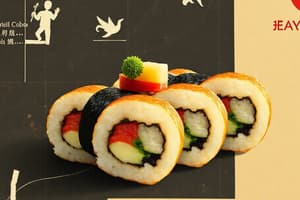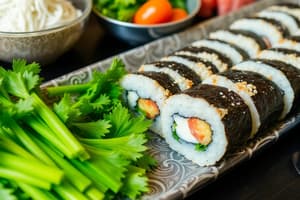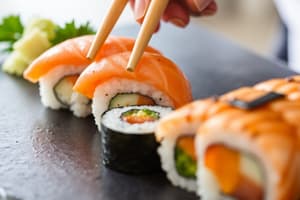Podcast
Questions and Answers
What defines Futomaki in the context of sushi?
What defines Futomaki in the context of sushi?
- Thick rolls with multiple fillings (correct)
- Hand-rolled sushi cones
- Inside-out rolls with rice on the outside
- Thin rolls with a single filling
Which type of sushi is characterized by hand-formed rice topped with fish or seafood?
Which type of sushi is characterized by hand-formed rice topped with fish or seafood?
- Maki
- Nigiri (correct)
- Inari
- Sashimi
Which of the following types of sushi is served without rice?
Which of the following types of sushi is served without rice?
- Chirashi
- Temaki
- Gunkan
- Sashimi (correct)
What is the main characteristic of Inari sushi?
What is the main characteristic of Inari sushi?
Which sushi type is often referred to as 'battleship sushi'?
Which sushi type is often referred to as 'battleship sushi'?
Which ingredient is primarily used to create a traditional Japanese broth?
Which ingredient is primarily used to create a traditional Japanese broth?
What is the main purpose of using mirin in Japanese cooking?
What is the main purpose of using mirin in Japanese cooking?
Which of the following flavors is predominantly derived from soy sauce in Japanese cuisine?
Which of the following flavors is predominantly derived from soy sauce in Japanese cuisine?
What is the significance of seasonality in Japanese cuisine?
What is the significance of seasonality in Japanese cuisine?
What role do pickles, known as tsukemono, play in Japanese meals?
What role do pickles, known as tsukemono, play in Japanese meals?
Flashcards are hidden until you start studying
Study Notes
Types of Sushi
-
Nigiri
- Hand-formed rice topped with fish or seafood.
- Often accompanied by a dab of wasabi.
-
Maki
- Sushi rolls wrapped in seaweed (nori).
- Typically filled with fish, vegetables, or other ingredients.
- Variations include:
- Hosomaki: Thin rolls with a single filling.
- Futomaki: Thick rolls with multiple fillings.
- Uramaki: Inside-out rolls with rice on the outside.
-
Sashimi
- Thinly sliced raw fish or seafood, served without rice.
- Often garnished with wasabi and soy sauce.
-
Temaki
- Hand-rolled sushi cones made from nori.
- Filled with rice, seafood, and vegetables.
-
Chirashi
- "Scattered" sushi served in a bowl with a bed of rice topped with various sashimi and garnishes.
-
Oshi
- Pressed sushi, often made in a mold.
- Topped with a protein and served in blocks.
-
Inari
- Sushi rice encased in sweetened fried tofu pouches.
- Typically served as a vegetarian option.
-
Gunkan
- "Battleship sushi" consisting of a strip of seaweed wrapped around rice, filled with soft toppings like roe or sea urchin.
-
Yaki
- Grilled sushi, which may include items like grilled eel (unagi) or other cooked seafood.
-
Narezushi
- Fermented sushi involving fish preserved in rice.
- One of the oldest forms of sushi, originating in Japan's centuries-old preservation methods.
Nigiri
- Hand-shaped rice topped with fish or seafood
- Often accompanied by wasabi
Maki
- Sushi rolls wrapped in seaweed (nori)
- Typically filled with fish, vegetables, or other ingredients
- Hosomaki: Thin rolls with a single filling
- Futomaki: Thick rolls with multiple fillings
- Uramaki: Inside-out rolls with rice on the outside
Sashimi
- Thinly sliced raw fish or seafood, served without rice
- Often garnished with wasabi and soy sauce
Temaki
- Hand-rolled sushi cones made from nori
- Filled with rice, seafood, and vegetables
Chirashi
- "Scattered" sushi served in a bowl with a bed of rice topped with various sashimi and garnishes
Oshi
- Pressed sushi, often made in a mold
- Topped with a protein and served in blocks
Inari
- Sushi rice encased in sweetened fried tofu pouches
- Typically served as a vegetarian option
Gunkan
- "Battleship sushi" consisting of a strip of seaweed wrapped around rice, filled with soft toppings like roe or sea urchin
Yaki
- Grilled sushi, which may include items like grilled eel (unagi) or other cooked seafood
Narezushi
- Fermented sushi involving fish preserved in rice
- One of the oldest forms of sushi, originating in Japan's centuries-old preservation methods
Ingredients in Japanese Cuisine
- Rice is the staple food and comes in varieties like white, brown, and sticky rice.
- Soy sauce is made from fermented soybeans and is central for seasoning and marinating.
- Miso is a fermented soybean paste used widely in soups and dressings.
- Dashi is a traditional broth made with kombu seaweed and dried bonito, providing a distinct umami flavor.
- Fresh fish and shellfish are essential ingredients for many dishes like sushi and sashimi.
- Japanese cuisine utilizes seasonal vegetables like daikon, cucumber, and eggplant.
- Tofu, made from soybean curd, is adaptable in soups, salads, and stir-fried dishes.
- Common noodle types include soba (buckwheat), udon (thick wheat), and ramen (thin wheat).
- Seaweeds like nori (used in sushi) and wakame (in soups and salads) contribute unique textures and flavors.
- Pickles, known as tsukemono, made from various vegetables, are often served as side dishes.
Flavors in Japanese Cuisine
- Umami, the fifth basic taste, is often enhanced in Japanese cuisine through dashi and miso, adding depth to dishes.
- Sweetness is typically derived from mirin (sweet rice wine) or sugar, used in teriyaki and certain sauces.
- Saltiness primarily comes from soy sauce, providing seasoning and contrasting flavors.
- Sourness is often derived from rice vinegar or citrus fruits like yuzu and lemon, used in dressings and marinades.
- Bitterness, present in certain vegetables and teas, is used in small amounts to balance flavors.
- Mild spiciness is offered by wasabi or shichimi togarashi (seven spice blend).
- Balancing flavors is essential in Japanese cuisine, with dishes often combining sweet, salty, and umami.
Key Concepts
- Seasonality is highly valued, emphasizing the use of fresh ingredients that are in season.
- Presentation plays a crucial role in Japanese cuisine, with dishes often beautifully arranged.
- Focus on natural ingredients promotes a healthy diet, adhering to principles of health and nutrition.
- Diverse culinary techniques such as grilling, steaming, and simmering are employed, preserving flavor and texture.
Studying That Suits You
Use AI to generate personalized quizzes and flashcards to suit your learning preferences.




